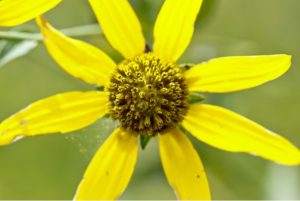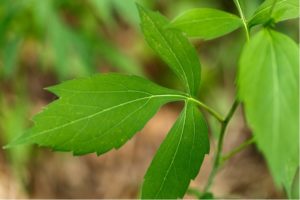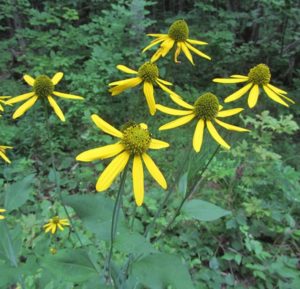From the blooms that provide nectar to butterflies, to the seeds that are eaten by goldfinches, to the leaves and stems used as food and medicine by harvesters, this plant is a very important native wildflower!
Characteristics:

“Rudbeckia laciniata (green-headed coneflower)”, by tgpotterfield, CC BY-NC-SA 2.0.
Sochan (Rudbeckia laciniata, or ᏐᏨᎾ in Cherokee), also referred to as the Cutleaf Coneflower or Green-Headed Coneflower, is a member of the Asteraceae/Sunflower plant family. The Asteraceae family plants are characterized by composites of many smaller flowers clustered on a flower head that appear to be a single flower from afar. Each large, colorful petal is an individual “ray” flower, while the center is composed of many small “disk” flowers, each with five petals. Each disk and ray flower produces a seed.
An herbaceous perennial, sochan is native to all the continental United States except for California, Oregon, and Nevada. Typically, the plant’s traditional habitat is alongside creeks and rivers, thriving in moist soil and tolerant of hot and humid summers. It can grow anywhere from three to ten feet tall, unless cultivated, in which case it may then only grow to be half that height. The two- to four-inch yellow flowers bloom late summer into fall, whereas the rosette of leaves at the base of the stem remains present through winter. Underground rhizomes can cause the plant to spread rapidly so to control the clumps must be divided. Deadheading the old flowers can also help the plant rebloom. Loss of habitat and concerns of overharvesting as sochan becomes more popular have been major issues; however, growing sochan has proven to be relatively easy if you have young plants and a full-sun to part shade spot to transplant them into!

“Rudbeckia laciniata (green-headed coneflower), leaf”, by tgpotterfield, CC BY-NC-SA 2.0.
Historical Uses:
Rudbeckia laciniata was used by the Chippewas for medicinal purposes, including for burns, gastrointestinal problems, and on horses. The blossoms were formed into a poultice to apply topically to burns, and infusions of the roots were used as a stimulant to a horse’s chest and legs; a similar infusion of the roots was taken for indigestion. But more important is the plant’s role as a food item. Sochan has been cooked as a medicinal spring salad to promote well-being. Cherokee Cooklore (1951) describes picking the leaves when the plants are still young, parboiling, washing, and frying in grease. The leaves and stems have also been cooked with eggs, poke, dock, cornfield creasy, and other greens. Sochan can be stored for future use by tying the leaves and stems together and hanging them to dry or allowing them to dry in the sun. They can also be preserved by blanching and boiling in a can with or without salt.

“Coneflower-(Rudbeckia-laciniata)”, by homeredwardprice, CC BY 2.0.
Sochan in the News:
Regulations of the National Park Service do not allow removal of resources from the Great Smoky Mountains National Park (GSMNP); these regulations have prevented the Cherokees from gathering plants like sochan from their ancestral lands. But sustainability research conducted by the Eastern Band of Cherokee Indian’s Cherokee Preservation Foundation on the harvesting of plants such as sochan and ramps (ᎤᏩᏍᏘᎭ, Allium tricoccum) found that gathering practices of tribal members would not have a negative impact on the park resources. Cherokee harvesting practices are performed in a sustainable manner that does not cause plant mortality but rather increases sochan stems, flowering, and fruiting.
In 2019, the Eastern Band of Cherokee Indians and the GSMNP reached an agreement to allow enrolled tribal members to gather sochan within the park boundaries if they had obtained the permit and official collection bags to do so. EBCI was among the first Tribes in the nation to write a request to gather important foods such as sochan and ramps. Thirty-six permits are distributed amongst EBCI tribal members each year, and those whose applications are approved also attend a training session on gathering. The gathering season is from March 1st to May 31st each year. This has helped make strides to restoring Cherokee practices that are thousands of years old!
For More Information:
Baumflek, Michelle, Tommy Cabe, Jonh Schelhas, and Maria Dunlavey. 2021. Managing forests for culturally significant plants in traditional Cherokee homelands: emerging platforms. International Forestry Review Vol.23(4).
Chiltoskey, Mary and Goingback. 1951. Cherokee Cooklore: Preparing Cherokee Foods. For the Museum of the Cherokee Indian. Coachwhip Publications Reprint Edition 2014. Edited by Mary Ulmer and Samuel E. Beck.
Eastern Band of Cherokee Indians Natural Resources. “Sochan Gathering in the Great Smoky Mountains National Park”. https://cherokeenaturalresources.com/sochan-gathering/
Elpel, Thomas J. 1967. Botany in a Day: The Patterns Method of Plant Identification, An Herbal Field Guide to Plant Families of North America. HOPS Press. Pony, MT.
Hamel, Paul B., and Mary U. Chiltoskey. 1975. Cherokee Plants and Their Uses—A 400 Year History. Sylva, North Carolina: Herald Publishing.
Moerman, Daniel E. 1998. Native American Ethnobotany. Timber Press, Portland, Oregon.
NC State Extension. https://plants.ces.ncsu.edu/plants/rudbeckia-laciniata/
Perry, Myra A. (1974). Food Use of “Wild” Plants by Cherokee Indians. Master’s Thesis, Department of Food Science and Technology, University of Tennessee, Knoxville. Electronic document, https://trace.tennessee.edu/utk_gradthes/1048/.
US Department of Agriculture, Natural Resources Conservation Service. 2022. PLANTS Database. Electronic document, https://plants.usda.gov/home.
